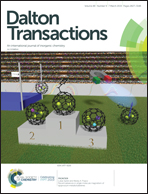Effects of a strong π-accepting ancillary ligand on the water oxidation activity of weakly coupled binuclear ruthenium catalysts†
Abstract
Significant differences were found in the proton-coupled redox chemistry and catalytic behavior of the binuclear [{Ru(H2O)(bpz)}2(tpy2ph)](PF6)4 complex [bpz = 2,2′-bipyrazine; tpy2ph = 1,3-bis(4′-2,2′:6′,2′′-terpyridin-4-yl)benzene] as compared with the structurally analogous derivative with 2,2′-bipyridine (bpy) instead of bpz. The differences were assigned to the stronger π-accepting character of bpz relative to bpy as the ancillary ligand. The expectation of a positive shift for the Ru-centered redox potentials was confirmed for the lower oxidation state species, but that trend was reversed in the formation of the high-valence catalytic active species as shown by a negative shift of 0.14 V for the potential of the [RuIV/V![[double bond, length as m-dash]](https://www.rsc.org/images/entities/char_e001.gif) O] process. Moreover, DFT calculations indicated a significant decrease of about 15% on the spin density and oxyl character of the [RuV
O] process. Moreover, DFT calculations indicated a significant decrease of about 15% on the spin density and oxyl character of the [RuV![[double bond, length as m-dash]](https://www.rsc.org/images/entities/char_e001.gif) O]3+ fragment. The significantly lower kcat(O2) for the bpz system was attributed to these combined electronic effects.
O]3+ fragment. The significantly lower kcat(O2) for the bpz system was attributed to these combined electronic effects.



 Please wait while we load your content...
Please wait while we load your content...